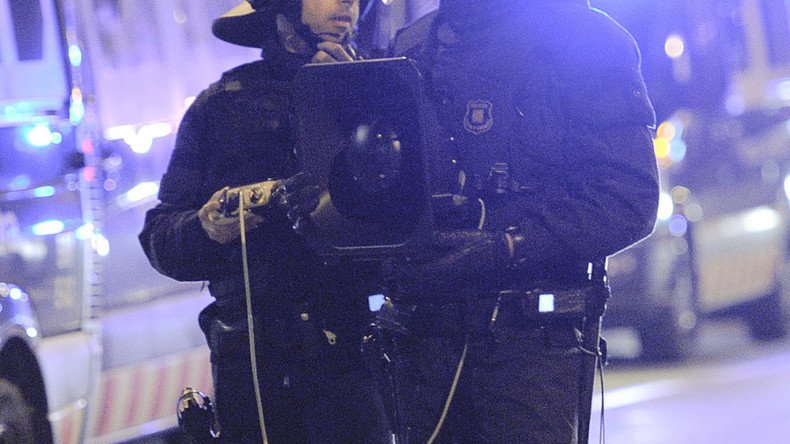NYPD sued over use of sound cannon on protesters

A lawsuit has been filed over the New York Police Department's use of a sonic weapon to disperse a December 2014 protest of a grand jury’s decision to not indict the officer who killed Eric Garner.
Five people, including photojournalists and protesters, who attended a December 2014 protest and fell victim to the Long Range Acoustic Device (LRAD) are suing the City of New York, Police Commissioner Bill Bratton, and the two officers responsible for deploying the device.
The complaint, filed Thursday, details alleged civil rights violations through the use of excessive force as well as violations of the First and Fourth Amendments to the United States Constitution.
The LRAD is capable of causing permanent hearing damage and loss of balance, according to its manufacturer. The weapon has been used for everything from warding off Somali pirates to dispersing G20 demonstrations.
The plaintiffs are seeking damages and looking to effectuate the release of documents detailing NYPD policies regarding the use of LRAD – and to have them adopt new policies regarding training and documentation of use.
The lawsuit follows a December 2014 letter [PDF] to NYPD Commissioner Bill Bratton by attorneys Gideon Oliver and Elena Cohen which claimed the LRAD caused injuries to their clients and requested the NYPD adopt new policies for its deployment.
The NYPD is reluctant to give comments regarding an ongoing lawsuit.
"All the allegations and relevant facts will be reviewed once the suit is served," a spokesman for the New York City Law Department said, according to Reuters.
#NYPD putting together their LRAD now for #EricGarner march! #StillCantBreathe#BlackLivesMatterpic.twitter.com/kFhPi1JWSg
— Ash J (@AshAgony) July 17, 2015
Keegan Stephen, a plaintiff in the case against the NYPD and others, spoke to RT about the events that occurred that night.
RT: What effect did the sound cannon have on you?
Stephen: It was a really piercing noise immediately. I could feel it beyond my eardrums and down my ear canal. And they were blaring it as they walked down the block and they stopped by the end of the block. The protest continued and I went with it for a while, then I left. I left the vicinity. I was far away from all the noise of the demonstration and I still had this incredible ringing in my ears. I couldn’t sleep that night. The ringing kept me up all night.
RT: Could you describe what an LRAD sounds like to somebody who has never heard one before?
Stephen: No, it’s pretty hard to describe. I mean, the technology makes it a different type of sound than you’ve ever experienced, the way that it turns sound into a cone, rather than a dissipate noise, is unique to the LRAD. So, I guess maybe the closest thing is a siren, which has the double doppler effect, of not being heard when you’re behind it. So it projects it in one direction, but this actually points it, so it’s like a beam of sound. So, it’s like a siren but drastically louder and more painful.
RT: Could you describe the protest for us? What was happening when the NYPD started using the LRAD?
Stephen: I was marching with the protest that was crossing town from West to East. I don’t know why, but suddenly several cops piled on one protester, a black man, and there were several cops on this guy’s back while they were cuffing him. And so, several other protesters were trying to get photographs of it, including myself, trying to photograph this person’s arrest in this intersection. Then suddenly, without warning, I was pepper-sprayed, and several other people there were also pepper-sprayed. We all ran away from the pepper spray. I ran to the sidewalk. And then they started deploying the LRAD.
I’ve seen the LRAD around ever since the RNC [Republican National Convention], saw it around Occupy Wall St. But I’ve never seen it used for anything other than an amplification device, you know they’ve spoken through it, but this was very obviously this sort-of weapon function and just pushing a button and creating this horrible shrieking noise that sent us all scattering.
RT: When was the last time you witnessed the deployment of an LRAD?
Stephen: I’ve seen them at every big protest, for sure. They have the large ones, the truck-mounted ones at the larger protest. And even at the smaller protests, especially where the new Strategic Response Group is present, they’ll have the small hand-held ones that they’re carrying around. And they use them as their standard amplification device at this point. They use it to make announcements. But it always has the capability to hit that weapon function and make this noise. I haven’t seen it happen since then [December 2014], but it’s always a possibility every time I see it around, which is a chilling possibility.
Truck-mounted LRAD (Long Range Accoustic Device or "Sound Cannon") here at NYC #BaltimoreUprising solidarity action. pic.twitter.com/Ik2jbWceyJ
— Keegan Stephan (@KeeganNYC) April 29, 2015
The night in which the plaintiffs are accusing the department of improperly deploying the device saw many arrests, as did the night prior. According to an organizer of a jail support team working with the National Lawyers’ Guild, the night of December 3rd saw 83 arrests resulting in mostly desk appearances for disorderly conduct. The night of the LRAD’s deployment, the NYPD claimed to have arrested 223.











